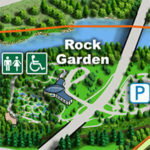| Membership | Price (+HST) |
|---|---|
| Single | $85/year |
| Single Plus | $120/year |
| Family | $130/year |
| Family Plus | $175/year |
| Contributing | $300/year |
| Supporting | $600/year |
| Sustaining | $1,000/year |
| Benefactor's Circle | $2,500/year |
| Director's Circle | $5,000/year |
| President's Circle | $10,000/year |
Sakura Zensen: The Advance of Cherry Blossoms
By Alex Henderson, Curator of Collections
Flowering cherries are deciduous trees with showy, ornamental flowers in spring, oval serrated leaves, with many species or cultivars having good fall colour. Some cultivars are also appreciated for having highly ornamental bark. RBG’s Japanese flowering cherry collection can be found both at the Arboretum and Rock Garden.
Perhaps the most spectacular grouping of trees is the Prunus ‘Accolade’ circle at the Arboretum which is one of spring’s most iconic sights at RBG. The trees were planted in 1966 and so in cherry terms are venerable in age. P. ‘Accolade’ is a spectacular pink semi-double flowered cultivar that has achieved the Royal Horticultural Society (RHS) Award of Garden Merit (AGM). These trees look most spectacular when viewed against the backdrop of a pure blue sky as the blue provides a stunning contrast to the pink flowers. In some years, the additional presence of the moon during the daytime adds extra drama to this spectacular scene. Once the flowers begin to fade and fall the surrounding grassy area looks like it is covered in pink confetti. Prunus ‘Accolade’ is also a bee magnet so a great choice to include in a wild-life garden.
The colour of cherry flower petals can vary considerably as the flowers change from first emergence through maturity to blossom fall. Typically, flowers are darker in bud becoming paler as they age and expand. Seasonal conditions, climate and soil type can also all have an influence on the annual colour of flowers. Cherry flowers are divided into four different groups which are based upon the number of petals:
- Single flowers have five petals
- Semi-double flowers have between 10 and 20 petals
- Double flowers have from 25 to 50 petals
- Chrysanthemum flowered cherries have more than 100 petals
Cherry trees in Japan play a hugely important role in Japanese society and culture. During cherry blossom time huge festivals are held as Japanese people hold parties and celebrations. The Japanese name the flowering cherry sakura and the art and celebration of viewing sakura is known as hanami (flower viewing) during daytime and yozakura (night sakura) at nighttime. The short-lived flowers are particularly important in Japanese culture as a symbol of the ephemeral and impermanent nature of life. The period of blossom fall is particularly important to Zen shrines around Japan where time is devoted to considering the beauty and still quiet of the falling petals. Cherry trees are often planted outside public buildings and schools and as flowering time occurs in April sakura are often associated with start of the financial and school year.
When planting cherries select a location with full sun and that is open and airy.
Cherries can be prone to wind damage and frost cracking in severe winters, so a sheltered site is also advisable. A south or southwest facing situation is ideal. Cherries should be planted in fertile, well-drained soil, rich in organic matter. Many garden cultivars are adaptable to a wide range of soils but avoid planting on heavy clay soils. Pruning techniques should only ever be employed to remove dead, diseased, rubbing or crossing wood. In general cherries are fast growing and in tree terms fairly short lived. Some cultivars may not live beyond 50-60 years in age.

















